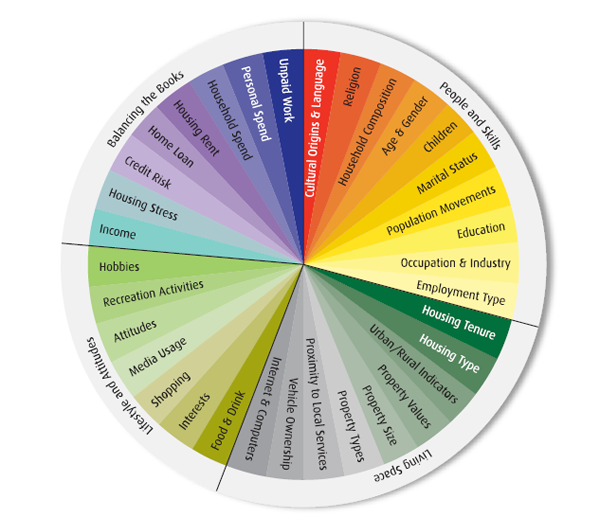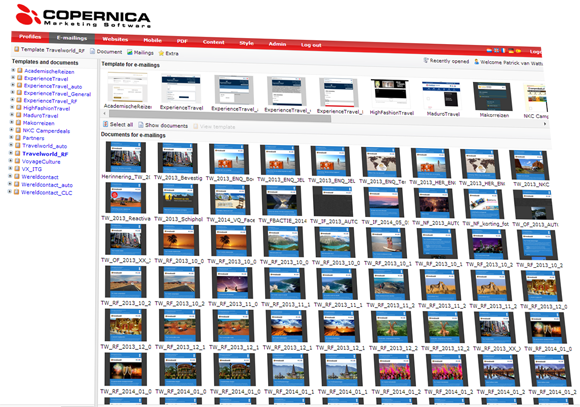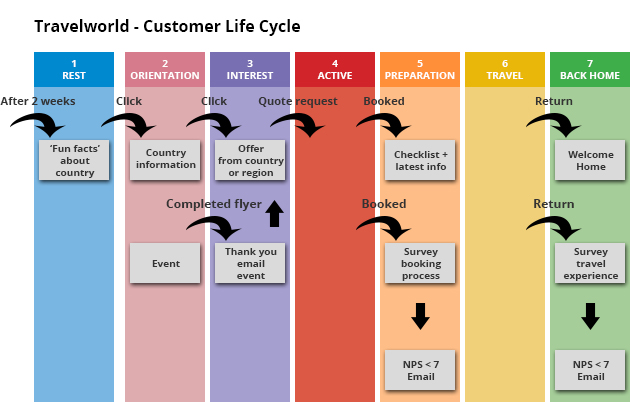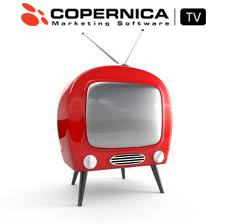Successful customer life cycle implementation at International Travel Group
by Walter van der Scheer
Implementing a customer life cycle in your marketing mix may sound simple, but automating a customer journey entails quite some efforts on the practical side. Email marketing and comprehensive databases have made automating a customer journey a lot easier, but it is the marketer who makes the difference. International Travel Group (ITG) has implemented a customer life cycle strategy revolving around personal email marketing campaigns. Learn how ITG has been able to implement a smart 7 phase customer life cycle and what role email marketing plays in increasing customer value.
Who are ITG?
A short introduction: ITG is a Dutch travel group that stands for 'unforgettable memories and travel experiences'. ITG caters to those who realize that a journey is far more than just a holiday. ITG trades with a number of specialized 'direct-selling' travel brands, divided in three main labels: WorldContact, ExperienceTravel and Travelworld. Although ITG has implemented a Customer LifeCycle (CLC) for every of its three brands, in this case study we will discuss the Travelworld implementation.
Travelworld offers budget-friendly far-away travels and focuses on contemporary travelers that value a well-organised holiday for an affordable price. Every sub label of the Travelworld brand represents a destination with its own individual specialists
Instead of via online one-size-fits-all bookings, the starting point for every holiday with TravelWorld is an online quote request. Upon receipt of a quote request, a travel specialist will personally contact the traveler to discuss his ideas and wishes. After the intake the holiday can be booked and confirmed.
The right content at the right time
Ultimately, ITG aims at providing a unique experience for every individual traveler, by using personal communications. Email marketing is one of the tools, albeit a vital element to reach this goal.
ITG uses various data sources to create the right contact strategy. The current campaigns are developed using click behavior, booking behavior and personal preferences as collected via various other sources. Because of the personal approach of ITG, all customer facing departments play a vital role in collecting personal preferences and other data as well.
Finally, ITG uses a specific model to determine whether an individual fits in with the intended target group: Experian's Mosaic model. Using this model, ITG is able to combine various data, like magazines read, house type, age, travel destinations, etcetera, to create a single customer view.
The Mosaic model also provides information about which channel and media to use.

The right time: 7 phases in the CLC
ITG's customer life cycle covers 7 phases.
1. Rest phase:
In this phase, the (future) customer has yet to decide on everything, leaving all options open: type of holiday, destination, duration, and more. All communication is focused on inspiration and information.

Travelworld sends a weekly inspirational email with a top-3 of worldwide destinations. As the content of the email is dynamic, every edition contains information about different destinations, for example:
- Top 3 most stunning nature reserves
- Top 3 most cultural rich destinations
- Etcetera
Profile information is automatically enriched in Copernica with clicking behavior, allowing Travelworld to target the campaigns in the next phase to the interests of this recipient. After a click, the recipient is moved into the next phase.
2. Orientation phase:
Because Travelworld now knows what kind of holidays appeal to the traveler, the weekly mailings are fully adjusted to these destinations.
Content is automatically retrieved from Travelworld's content management system, which is directly integrated with Copernica Marketing Software.
A click on a specific call to action in the orientation phase emails will bring the traveler to the next phase.
3. Interest phase:
Using the collected information about the individual interests in specific countries and/or holidays, Travelworld is now able to offer concrete packages. During this phase, the traveler receives an email with the holidays and offers that have a fit with his personal preferences and behavior.
All calls to action in this emails are aiming at a request for a quote. Directly after receipt of a quotation request, Travelworld moves the traveler to the next phase.
4. Active phase:
With most of the lead generation work done, email marketing temporarily is put on the back burner and the sales ready lead is transfered to the travel specialist. In order not to interfere with the booking process, in this phase Travelworld sends as little emails as possible.
But from a tactical approach and to support the booking process, Travelworld has a few email marketing touch points up its sleeve. After a second quote, for example, when no booking has been done yet, an offer is sent to remind the traveler of the fact that his offer will expire soon or that the number of tickets is limited for the selected flight. By creating a sense of urgency, Travelworld stimulates the decision to make a booking.

5. Preparation phase:
As soon as a customer has made his booking, he is brought over into the preparation phase. The traveler receives a number of emails, depending on the remaining time before departure. A typical schedule could look like this:
- Five months before departure
- Two months before departure
- Two weeks before departure
All three emails contain useful information regarding the booking, as well as relevant cross sell opportunities, like:
- Upgrade to business class today for only £ 100 per person
- Arrange your transportation to and from the airport (taxi, train,…)
- But also offers for suit cases, insurances, visa
- Etcetera
During ths phase, the traveler will also receive an invitation for a research to evaluate the booking process. If the overall score fails to reach a certain threshold, the team of travel specialists receive a notification to contact the customer. Also, this information is used to improve the future customer experience.
6. Travel phase:
Although internet connections are available in most places today, it is not a commodity everywhere yet. During the trip, Travelworld does not use email to communicate with the traveler.
7. Back home phase:
In conclusion of the whole customer journey, upon return, the traveler receives a "Welcome home'- email. Displayed content includes:
- Create your photo album online
- Share your travel experiences (via social media)
- Update your travel preferences
- Etcetera
Two weeks after returning home the customer receives this email and is then automatically put back into the rest phase. Unless the customer has updates his travel preferences, because that would launch him straight into either the orientation or interest phase.
So, to wrap it up, here's a visualization of the whole campaign flow:

Before you get started! – ITG's learnings
With this case study of Travelworld, ITG shows that it is possible to integrate a complex customer life cycle in a B2C email marketing program. Although the exact touch points could differ per industry or company, Travelworld shows the potential of a CLC implementation.
Getting numerous systems in sync of each other can be time consuming. Before getting started, ask yourself the following questions: Which data do I really need? Which data is irrelevant? Where do I get the content from?
Be aware of your internal processes. Which departments have a role in collecting customer data? The personal contact with a travel specialist is a key aspect of ITG's approach and can't be replaced by automation. In this particular case, because of the role of travel specialists adding profile information, the flexibility of the CRM system is essential. Before you get started, decide on the way that you are going to collect, store and combine data to create the enriched customer profile.
So finally we get to the brain of the customer life cycle: the database. Data optimization is a continuous process. In order to avoid losing the plot of all the data and processes, you have to decide how you are going to process data and how you can ensure scalability. ITG experienced first hand that a lot of the time spent goes into fine-tuning the program. A strong foundation will save a lot of time and headache later on!





